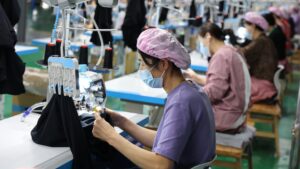Navigating the Impact of U.S.-China Trade Tariffs: A Shift for Manufacturers
Introduction
In recent months, the textile manufacturing landscape in China has faced significant challenges due to heightened U.S. tariffs. As companies grapple with these changes, many are reassessing their production strategies and exploring new markets. At Extreme Investor Network, we aim to provide a comprehensive look at these developments and their implications for investors and industry stakeholders.
The Ripple Effect of Tariffs
Reports indicate that numerous factories, particularly in key export hubs like Yiwu and Dongguan, have halted production or reduced their workforce as the effects of tariffs begin to bite. Cameron Johnson, a senior partner at Tidalwave Solutions, highlighted that industries producing toys, sporting goods, and low-cost consumer goods are the hardest hit. While these disruptions may not be large-scale yet, the threat of increased furloughs looms, raising concerns about long-term job losses in a sector that employs millions.
According to Goldman Sachs, between 10 million to 20 million workers are involved in U.S.-bound export businesses. With China’s urban workforce numbering 473.45 million, any significant disruption could have lasting economic implications.
The Scope of the Tariff Challenge
With tariffs more than doubling recently, the impact on small businesses could be devastating. Ash Monga, CEO of Imex Sourcing Services, cited that for many smaller companies, the financial strain might be unbearable, threatening their very existence. In response, Monga is launching a "Tariff Help" website to assist small businesses in finding alternative suppliers outside of China.
Innovation Amidst Adversity: Enter Livestreaming
Manufacturers are not merely waiting for conditions to improve; they are actively seeking out innovative sales strategies. Companies like Woodswool, an athleticwear manufacturer, have pivoted to online sales through livestreaming platforms, a trend gaining traction across China. Manager Li Yan noted that their online efforts garnered over 30 orders shortly after launch, indicating a positive response from consumers.
Major tech companies are stepping up to support these transitions. Baidu, for example, is offering subsidies and AI tools to help manufacturers create domestic e-commerce channels, boosting their resilience amid uncertainty.
Challenges in the Domestic Market
Despite these efforts, the shift to domestic sales brings new hurdles. JD.com and Meituan have pledged significant investments to help redirect export goods to domestic consumers, but there remains a vast gap—$27.22 billion represents only 5% of last year’s exports to the U.S. Additionally, many manufacturers find that products designed for suburban American consumers may not resonate as well with those in urban China.
There’s a growing sense of competition among local companies, further complicating the market landscape for exporters.
Exploring Beyond U.S. Borders
With increasing scrutiny on transshipping exports through third countries, many companies are beginning to look beyond the U.S. for market opportunities. Ashley Dudarenok, founder of ChoZan, has noted a shift towards diversifying production to regions like India and establishing connections with customers in Europe and Latin America.
Companies such as Beijing Mingyuchu demonstrate this resilience by successfully selling bathroom products to Brazil, exemplifying how businesses can thrive even amid geopolitical tensions.
In response to the challenges posed by rising tariffs, logistics companies like Cotrie Logistics in Ghana are stepping up to provide dependable trade routes and services between China and Africa, showcasing the potential for alternative trade partnerships.
Conclusion
As the U.S.-China trade relations continue to evolve, manufacturers and investors must remain agile. The ability to pivot towards new markets, embrace innovative sales strategies, and navigate domestic challenges will define the future of many businesses.
At Extreme Investor Network, we are committed to providing you with in-depth analyses and insights to help you thrive in this changing landscape. Stay informed, and connect with us to explore the future of international trade and investment.
Subscribe Now!
For weekly insights from Asia’s largest economy, sign up for our newsletter and stay ahead of the curve in the dynamic world of finance.
This blog format not only provides a detailed overview of the ongoing situation but also offers actionable insights and strategic advice, elevating our content as a valuable resource for readers and investors alike.

